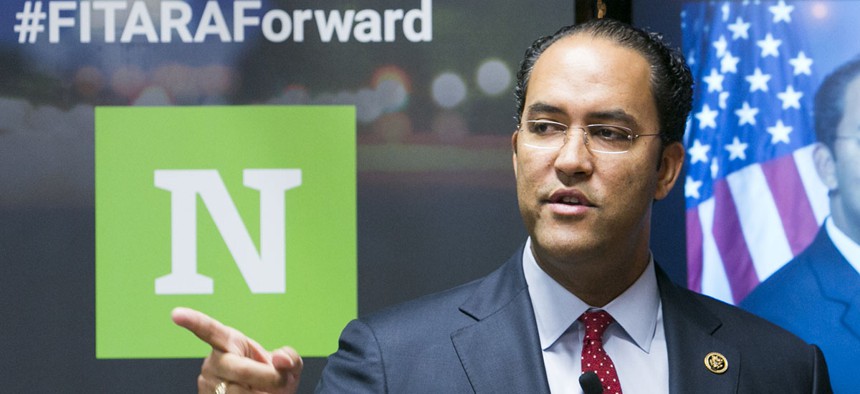FITARA: How IT Reform Became ‘Sexy’

Rep. Will Hurd, R-Texas Kristoffer Tripplaar
FITARA is finally beginning to get the kind of attention from Congress, overseers and the public that one might expect of an area in which the government spends upward of $80 billion annually.
Speaking Dec. 16 in Washington about IT reform legislation he began crafting nearly two years ago with Rep. Darrell Issa, R-Calif., Rep. Gerry Connolly, D-Va., lamented for a moment about its rocky start.
“When I first started working on this legislation, I thought to myself, ‘Here I go again, can I ever have a sexy bill?’” Connolly said, recalling other apparently dowdy efforts he championed in years past, including foreign aid reform.
“The Federal Information Technology Acquisition Reform Act -- you can’t even get it all out on a bumper sticker,” Connolly said. “And then the rollout of the healthcare website” -- HealthCare.gov -- “happened. And all of the sudden, people understood the importance of IT management and understood it could actually bring down an entire program.”
And it’s finally beginning to get the kind of attention from Congress, overseers and the public that one might expect of an area in which the government spends upward of $80 billion annually.
The private sector has benefited much more easily from smartphones, the social media revolution and increased access to broadband. The government is playing catch up not only when it comes to adopting emerging tech but also at securing it.
As U.S. Comptroller General Gene Dodaro stated later at the same event, hosted by Nextgov, federal information security has been on the Government Accountability Office’s High-Risk List since 1997. For almost 20 years, agencies have struggled with securing technology.
Yet, change is in the air. While improving IT security is still a major problem and fallout from the OPM hack continues almost daily, it’s clear IT reform has trumped partisanship in Congress and become a key priority for the Obama administration.
“Not once did I say ‘IT procurement’ on the campaign trail,” said Rep. Will Hurd, R-Texas, who also chairs the House Oversight and Government Reform committee’s IT subcommittee. “You don’t hold rallies for ‘IT procurement."
But since he’s taken office, Hurd, a former techie for the Central Intelligence Agency, has been talking a lot about IT procurement, IT reform and emerging technologies all across the country, from the Beltway to the DefCon hacker conference in Las Vegas.
Gonna start a rally for reforming #IT procurement with this standing room only crowd at @Nextgov #fitaraforward pic.twitter.com/ZsO1cbdGst
— Rep. Will Hurd (@HurdOnTheHill) December 16, 2015Hurd’s subcommittee and staffers did the lion’s share of work in creating the first FITARA implementation scorecards for federal agencies.
“If we get this right, we reduce the size and scope of government and, ultimately, the American people keep more money in their pockets,” Hurd said.
Dodaro, who leads Congress’ investigative arm, believes FITARA can save the government billions of dollars annually through a combination of enhanced CIO authorities, more transparent spending and efficiency returns.
But federal agencies, he said, have gotten in their own way in achieving IT objectives in the past.
“Over the past six years, [GAO] has made over 800 recommendations for improvement to try to achieve these objectives in IT,” Dodaro said. “But only 32 percent have been implemented.”
Dodaro said agencies often either disagree or agree with GAO’s recommendations but fail to comply with them in timely fashion. The result tends to be wasted taxpayer dollars.
So far, agencies are progressing on FITARA, making good-faith efforts to meet deadlines imposed by the law and the Office of Management and Budget. Early implementation grades weren’t great – agencies earned a "D" average. Yet, as Connolly stated, agencies now have a baseline to improve upon. In other words, a D grade may be better than an "Incomplete." It may take longer to fix systemic cultural problems – a challenge repeated by several government panelists – but FITARA is here to stay.
Dodaro said GAO will continue to study FITARA’s ramifications in the coming year. Its successful implementation is “essential” toward righting a decade’s worth of IT wrongs and missteps.
“All the provisions of FITARA, if effectively implemented, can contribute also to helping improve management of IT and performance in helping achieve a better return on investment and goals going forward,” Dodaro said. “It’s essential.”
The beginning of 2016 is an important time for FITARA. Doggedly pushed by U.S. Chief Information Officer Tony Scott, members of Congress and industry executives, FITARA may not be “sexy” yet, but at least it’s part of the vernacular of government and IT stakeholders.
“Right now, we have a moment in time where industry, OMB, the executive branch and Congress – on a bipartisan basis – are all in agreement with implementing this bill and making it work,” Connolly said. “If you were to listen to the conversations we have on the Hill, you would not know who is a Democrat and who is a Republican on this subject. There aren’t a lot of conversations like that on the Hill. We can use IT as a transformative tool that changes how we do business, provide services and how we interact among ourselves.”
Civil conversations in Congress? What could be sexier than that?
NEXT STORY: Video: The Year in Tech






